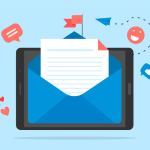Introduction.
Email marketing may seem like old news compared to shiny, new digital marketing trends, but it’s one of the most reliable and cost-effective ways to connect with your audience.
Why? Because even in today’s era of social media and push notifications, email remains a vital part of our lives. Consider this: by 2024, the number of email users is expected to top 4.5 billion worldwide.
That’s a lot of people you can reach just by crafting the right message and clicking “send.”
If you’ve been wondering how to step up your email marketing game, you’re not alone. With so many options for connecting with potential customers, it can be easy to overlook email—or misunderstand how best to use it.
That’s where having an effective strategy comes into play. A good plan ensures your emails are opened, read, and acted upon rather than sent straight to the junk folder or left unopened.
But before diving into tactics, let’s talk about why having a strategy is so essential.
Why Having an Email Marketing Strategy Matters
Imagine sending emails with no real thought behind them. You might spam your subscribers too often or not enough. Your messages could come across as random, irrelevant, or—worst of all—annoying.
Without a strategy, it’s easy to hurt your reputation or lose subscribers altogether. And once people stop opening your emails, it’s hard to get them back.
A well-crafted email marketing strategy lets you focus on sending valuable, engaging content to your audience. It helps you identify who you’re speaking to, what you want to communicate, and the best way to do it.
With a plan, you can analyze what works and refine your approach over time. And the best part? Email marketing has one of the highest returns on investment (ROI) compared to other marketing channels.
According to a study by Litmus, businesses can earn an average of $36 for every $1 spent on email marketing. That’s a serious payoff!
What Goes into a Great Email Marketing Strategy?
Creating an effective plan might feel intimidating, but breaking it down into smaller steps makes it manageable. Here’s a comprehensive guide to help you understand the basics:
1. Define Your Goals.
Are you trying to drive traffic to your website? Promote a new product? Increase engagement with your content?
Knowing what you want to achieve helps you tailor your message to hit the mark. Remember, you can have multiple goals, but they should all align with your broader marketing objectives.
2. Know Your Audience.
Understanding who you’re emailing is crucial. Use audience segmentation to divide your list into meaningful groups based on factors like age, location, past purchases, or interests. This allows you to send more personalized and relevant content.
For example, a clothing store might send different emails to customers in summer-dominant regions than to those in colder areas.
3. Create Engaging Content.
Content is king, even when it comes to email marketing. Your emails should provide value. Think about what your subscribers want to hear.
Maybe it’s a helpful tip, an exclusive offer, or a story they can relate to. Avoid long paragraphs and complicated words; keep it short, simple, and visually appealing.
4. Design for Mobile.
Over 60% of emails are opened on mobile devices, so optimizing for smartphones is non-negotiable.
Use responsive designs and make sure your emails are easy to navigate with a simple, scannable layout. Otherwise, your audience might get frustrated and hit “delete.”
5. Test and Analyze.
Sending your emails is just the beginning. Keep an eye on your open rates, click-through rates, and conversions. What kind of subject lines get more clicks?
Do your readers prefer images or text-only emails? Use A/B testing to find out what works and refine your strategy accordingly.
Pros and Cons of Email Marketing
Let’s dive into the good and the not-so-good sides of email marketing to give you a balanced view:
Pros:
- High ROI: As mentioned earlier, email marketing offers a phenomenal return on investment, making it ideal for businesses of all sizes.
- Targeted and Personalized: Unlike a social media post, email allows for more personalized communication tailored to individual needs.
- Automation Saves Time: Automation tools let you schedule campaigns, set up welcome series, or follow up with customers who abandon their carts—all with minimal effort.
- Easy to Measure: With analytics, you can track everything from open rates to sales conversions, giving you insight into what’s working and what needs improvement.
Cons:
- Spam Filters: If your emails aren’t crafted carefully, they can end up in spam folders, reducing your visibility and effectiveness.
- Overcrowded Inboxes: With so many brands vying for attention, it can be challenging to stand out.
- Regulations and Compliance: Laws like GDPR mean that you need to be cautious about how you collect and use data, which can add complexity to your strategy.
FAQs
Q: How often should I send marketing emails?
A: There’s no one-size-fits-all answer, but consistency is key. Many businesses find that sending one to four emails a month strikes the right balance. However, it all depends on your industry and audience preferences.
Q: What is the best day to send marketing emails?
A: Research suggests that Tuesdays and Thursdays tend to have higher open rates. That said, it’s best to experiment with different days and times to see what works for your audience.
Q: How can I grow my email list?
A: Offer value in exchange for subscriptions, like a discount code or a free resource. Make sure your sign-up forms are easy to find on your website, and consider using social media to promote your newsletter.
Q: Should I use an email marketing tool?
A: Yes, email marketing tools like MailChimp, HubSpot, or Constant Contact make it easier to automate, track, and optimize your campaigns.
Q: How do I avoid the spam folder?
A: Make sure to use a verified email domain, avoid using spammy words in your subject line, and always get explicit permission from your subscribers. Also, keep your email list clean by removing inactive addresses.
Final Thoughts
Email marketing is more than just sending messages to people who’ve opted in. It’s about building relationships, staying relevant, and delivering value in every communication.
As you refine your strategy, don’t be afraid to experiment and learn from your audience. Their feedback is your best guide.
Now that you’ve got a solid foundation for building an effective email marketing strategy, what aspect are you most excited to implement? Is there something specific you’d like to improve in your email marketing efforts?




GIPHY App Key not set. Please check settings